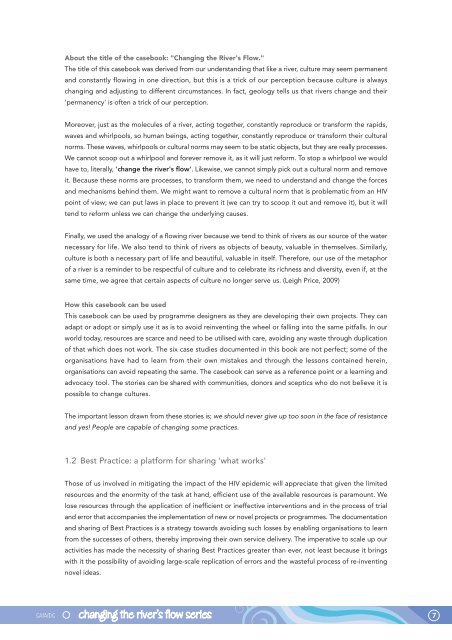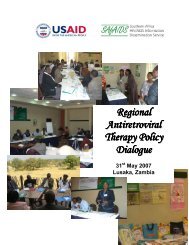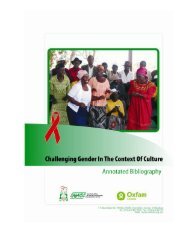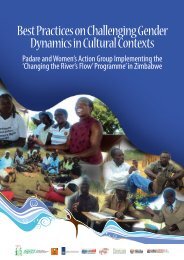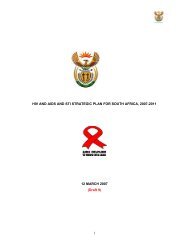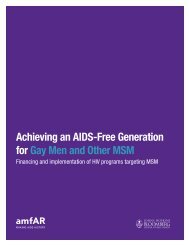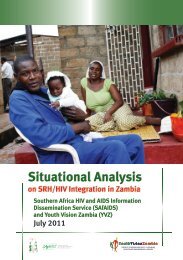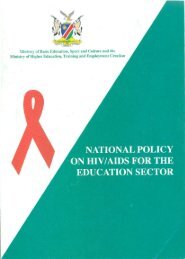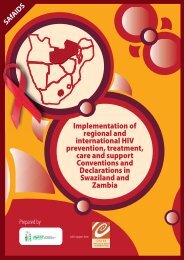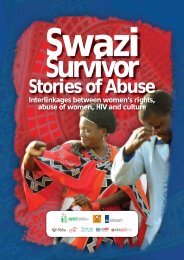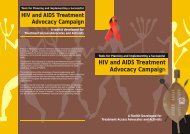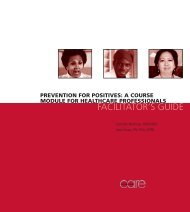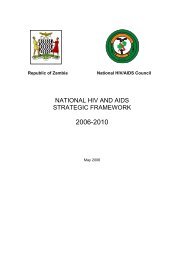Zimbabwean stories of "Best Practice" - SAfAIDS
Zimbabwean stories of "Best Practice" - SAfAIDS
Zimbabwean stories of "Best Practice" - SAfAIDS
You also want an ePaper? Increase the reach of your titles
YUMPU automatically turns print PDFs into web optimized ePapers that Google loves.
About the title <strong>of</strong> the casebook: "Changing the River's Flow."The title <strong>of</strong> this casebook was derived from our understanding that like a river, culture may seem permanentand constantly flowing in one direction, but this is a trick <strong>of</strong> our perception because culture is alwayschanging and adjusting to different circumstances. In fact, geology tells us that rivers change and their'permanency' is <strong>of</strong>ten a trick <strong>of</strong> our perception.Moreover, just as the molecules <strong>of</strong> a river, acting together, constantly reproduce or transform the rapids,waves and whirlpools, so human beings, acting together, constantly reproduce or transform their culturalnorms. These waves, whirlpools or cultural norms may seem to be static objects, but they are really processes.We cannot scoop out a whirlpool and forever remove it, as it will just reform. To stop a whirlpool we wouldhave to, literally, 'change the river's flow'. Likewise, we cannot simply pick out a cultural norm and removeit. Because these norms are processes, to transform them, we need to understand and change the forcesand mechanisms behind them. We might want to remove a cultural norm that is problematic from an HIVpoint <strong>of</strong> view; we can put laws in place to prevent it (we can try to scoop it out and remove it), but it willtend to reform unless we can change the underlying causes.Finally, we used the analogy <strong>of</strong> a flowing river because we tend to think <strong>of</strong> rivers as our source <strong>of</strong> the waternecessary for life. We also tend to think <strong>of</strong> rivers as objects <strong>of</strong> beauty, valuable in themselves. Similarly,culture is both a necessary part <strong>of</strong> life and beautiful, valuable in itself. Therefore, our use <strong>of</strong> the metaphor<strong>of</strong> a river is a reminder to be respectful <strong>of</strong> culture and to celebrate its richness and diversity, even if, at thesame time, we agree that certain aspects <strong>of</strong> culture no longer serve us. (Leigh Price, 2009)How this casebook can be usedThis casebook can be used by programme designers as they are developing their own projects. They canadapt or adopt or simply use it as is to avoid reinventing the wheel or falling into the same pitfalls. In ourworld today, resources are scarce and need to be utilised with care, avoiding any waste through duplication<strong>of</strong> that which does not work. The six case studies documented in this book are not perfect; some <strong>of</strong> theorganisations have had to learn from their own mistakes and through the lessons contained herein,organisations can avoid repeating the same. The casebook can serve as a reference point or a learning andadvocacy tool. The <strong>stories</strong> can be shared with communities, donors and sceptics who do not believe it ispossible to change cultures.The important lesson drawn from these <strong>stories</strong> is; we should never give up too soon in the face <strong>of</strong> resistanceand yes! People are capable <strong>of</strong> changing some practices.1.2 <strong>Best</strong> Practice: a platform for sharing 'what works'Those <strong>of</strong> us involved in mitigating the impact <strong>of</strong> the HIV epidemic will appreciate that given the limitedresources and the enormity <strong>of</strong> the task at hand, efficient use <strong>of</strong> the available resources is paramount. Welose resources through the application <strong>of</strong> inefficient or ineffective interventions and in the process <strong>of</strong> trialand error that accompanies the implementation <strong>of</strong> new or novel projects or programmes. The documentationand sharing <strong>of</strong> <strong>Best</strong> Practices is a strategy towards avoiding such losses by enabling organisations to learnfrom the successes <strong>of</strong> others, thereby improving their own service delivery. The imperative to scale up ouractivities has made the necessity <strong>of</strong> sharing <strong>Best</strong> Practices greater than ever, not least because it bringswith it the possibility <strong>of</strong> avoiding large-scale replication <strong>of</strong> errors and the wasteful process <strong>of</strong> re-inventingnovel ideas.7


